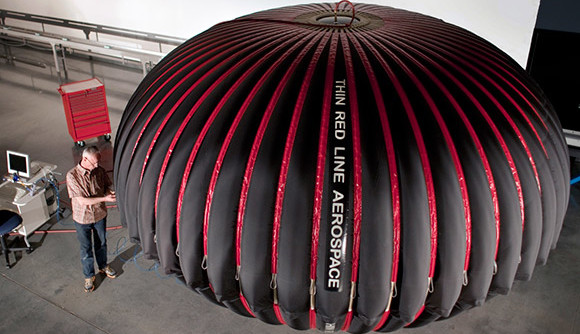Energy Bags Can Ensure Continuity In Electricity Supply
June 07, 2011
on
on

The transition from fossil fuels to renewable energy sources presents a lot of challenges. One of them is intermittency. Especially wind and solar sources depend on favorable weather conditions to supply electricity. On cloudy windless days energy storage systems are necessary to ensure continuity in electricity supply. Batteries are an option but they are still very expensive and not very green.
The Canadian firm The Thin Red Line Aerospace has come up with a green, low-cost solution for energy storage: Energy Bags. The method of compressed air energy storage (CAES) is used. The bags are filled with air when a surplus of energy is generated and at peak demand the air is released to drive electrical generators. CAES isn’t new but it involves engineering complex and costly pressure tanks.
The novelty of the bags is that the ocean is used as the pressure agent. At 600 meters (2000 feet) below sea level pressure is about 60 to 70 times higher than on the surface. A bag only weighs 75 kilograms (165 pounds). Yet once it is filled with air it displaces 40 tons of seawater. Fiber tendons chained to the seabed will keep the bag from floating up once it is being filled with air. When completely filled the bag measures only 20 meter (66 feet) in diameter but it stores 70 MW hours of energy.
Ideally the Energy Bags will be chained to the seabed along side offshore wind farms. Energy produced by the wind turbines will fill up the bags with compressed air when they are overproducing. When the wind drops or demand peaks the air can be released to ensure continuity.
Photo: The Thin Red Line Aerospace
The Canadian firm The Thin Red Line Aerospace has come up with a green, low-cost solution for energy storage: Energy Bags. The method of compressed air energy storage (CAES) is used. The bags are filled with air when a surplus of energy is generated and at peak demand the air is released to drive electrical generators. CAES isn’t new but it involves engineering complex and costly pressure tanks.
The novelty of the bags is that the ocean is used as the pressure agent. At 600 meters (2000 feet) below sea level pressure is about 60 to 70 times higher than on the surface. A bag only weighs 75 kilograms (165 pounds). Yet once it is filled with air it displaces 40 tons of seawater. Fiber tendons chained to the seabed will keep the bag from floating up once it is being filled with air. When completely filled the bag measures only 20 meter (66 feet) in diameter but it stores 70 MW hours of energy.
Ideally the Energy Bags will be chained to the seabed along side offshore wind farms. Energy produced by the wind turbines will fill up the bags with compressed air when they are overproducing. When the wind drops or demand peaks the air can be released to ensure continuity.
Photo: The Thin Red Line Aerospace
Read full article
Hide full article


Discussion (0 comments)